How to make authentic German donuts in the style of Bavaria. Learn how they are different from other German desserts and pastries categorized as donuts such as the Berliner.
Go straight to the Recipe Card or
Read on for useful information and step-by-step pictures (2 mins).
What are German Donuts?
German donuts are soft, puffy yeast dough circles, shaped to have a thin, shallow center and a raised outer edge. When fried to golden perfection the indented middles remain a lighter color.
Most commonly they are enjoyed liberally dusted with confectioners sugar or vanilla sugar.
They are not filled with Bavarian cream. In fact, they are not filled with anything, they are simply pulled into shape which is why one of their regional names is Ausgezogene Krapfen (literally pulled donuts).
Bavarian donuts are also known as Knieküchle and Auszogne. In Austria they call them Bauernkrapfen (farmhouse donuts). In the past the fried dough treats were mostly made on holidays and special occasions such as Christenings. Today they are a popular item on beer garden menus, at folk fests and fairs and have become an iconic German dessert and a well-loved Oktoberfest treat.
This authentic recipe from Chris’s collection from the Kaltenberg can be easily scaled down for half the amount or up if you are making the donuts for a larger party.
Ingredients You Need for German Doughnuts
The yeast dough for Ausgezogene Krapfen is simple to prepare. In Bavarian cuisine the same dough is also used to bake Buchteln, which are soft bread rolls filled with fruit or jam and eaten with warm vanilla sauce.
Yeast. The bread dry yeast is truly the star of the show. It creates the soft texture of the dough and the esters it releases infuses the donuts with delicious aromas.
Sugar. Only a minimal amount is used, primarily to feed the yeast.
Milk. Milk is the ingredient which imparts a delicate sweetness to the dough as yeast does not feed on lactose.
Flour. Use all-purpose flour.
Salt. Just a pinch to bring out the milk’s sweetness.
Eggs. They add structure and stability to the dough as well as additional moisture.
Rum. Optional. Not commonly done, but sometimes, especially in Austria, a shot of rum is added to the dough.
Frying oil. You can use vegetable cooking oil and you will have excellent results. Traditionally a combination of two kinds of frying agents were used – lard and butter, or vegetable shortening and cooking oil.
NOTE: Authentic German donuts are different from Berliner Pfannkuchen (Berlin pancakes) which are deep fried pastries with a filling of jam or custard piped in and are simply a version of other European donuts such as Portuguese malasadas.
How to Make Bavarian Donuts
There are three key points to remember in an otherwise simple process. If you get them right you will enjoy perfectly light and crispy naked donuts.
The first two require patience, the last one attentiveness. No hard work is involved.
- You need strong yeast. Allow the instant yeast enough time to get activated and strengthen before you mix the dough.
- Allow the dough plenty of time to rise (both bulk and individual balls). The light and soft texture of the donuts depends on this.
- Keep the frying fat at a temperature between 340-350 F. Not overcrowding the pan is very helpful.
Make the Dough
Step 1. Warm up the milk (keep it under 90 F so as not to kill the yeast) and pour it in the mixing bowl of a stand mixer. Add the sugar and the yeast. Stir gently and let the yeast activate – it will begin to produce bubbles (#3) as it eats the sugar.
NOTE: Bread yeast does not eat lactose from the milk so when activated the yeast will not look as foamy as if you had used water and sugar.
Step 2. Add flour, salt, soft or melted butter and eggs to the activate yeast and milk mixture (#4, 5, 6).
Step 3. Use the dough hook attachment on medium low speed until you get a soft but not sticky dough that has cleanly pulled away from the bowl sides (#8 below). Cover the dough with plastic and let it sit in a warm place for about an hour until it doubles in size (#9, 10).
Step 4. After the dough has risen flour a clean surface and place it on top. Divide it in two, then in two again and twice more until you get 16 more or less equal in size and weight parts. Shape them into balls and do not worry about uniformity too much. These are low key, rustic style donuts.
Step 5. Apply a bit of oil over each ball, cover with plastic to prevent air access and then a towel and let them rise for another 15-20 minutes (#2, 3, 4 below).
Shaping Techniques
Granted, the word technique is a bit over the top here, but there are a couple of different ways to shape the yeast dough balls into the traditional indented krapfen rounds.
- You can employ the thumb print cookie method (I personally find it easiest).
- You can use a small ramekin or jar with rounded bottom to press a ball of dough on top and then using your fingers gently force the sides down, thinning out the middle.
- Press a small ramekin or jar with rounded bottom on top of a dough ball and continue pressing while gently twisting until you get the desired shape.
Fry the Donuts
Step 1. Heat enough oil to fill your frying pot about 2-3 inches deep. Maintaining 340-350 F is essential so do not futz with the heat and do not fry more than three donuts at a time.
Step 2. Fry with the indentation facing down first – you will notice the centers puff up (#1 below). Once golden flip with a slotted spoon and fry the bottoms. Drain onto paper towels or over a cooling rack mounted over a baking sheet.
TIP: To guarantee that the center remains a lighter color than the edges make sure that after you turn the donuts over there is no oil pooled in the middles. Gently lift and tilt each donut to remove excess oil.
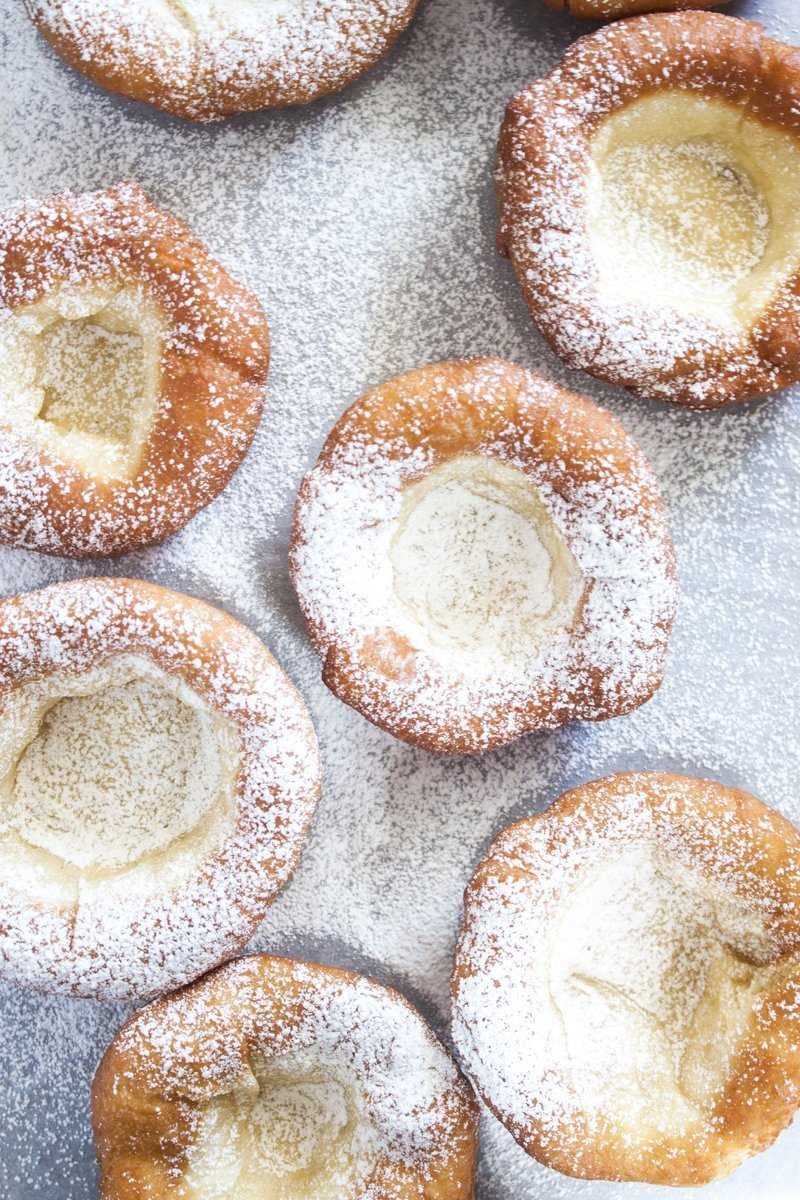
Bavarian donuts taste best when eaten right away – fresh freshly fried and still warm.
Ways to Enjoy German Donuts
- The most common way to serve them in Germany is to dust them with powdered sugar or dip them in vanilla sugar while they are still hot.
- In Austria apricot jam is a popular accompaniment – it is simply spooned into the middles of the donuts. So try them with your favorite preserve. Or Nutella or plum or strawberry jam.
- If you really want to turn them into Bavarian cream donuts – no problem. Simply add some in the middle – here is an authentic Bavarian cream recipe you can make in advance and let set in the fridge.
Other Bavarian Specialties
Bavarian Cream
Apple Ring Fritters
Sauerkraut Strudel
Beer Brats
Limburger Cheese Salad
Schweinshaxe
Bavarian Obatzda (Camembert Cheese Dip)
List of German Desserts including several Bavarian ones.
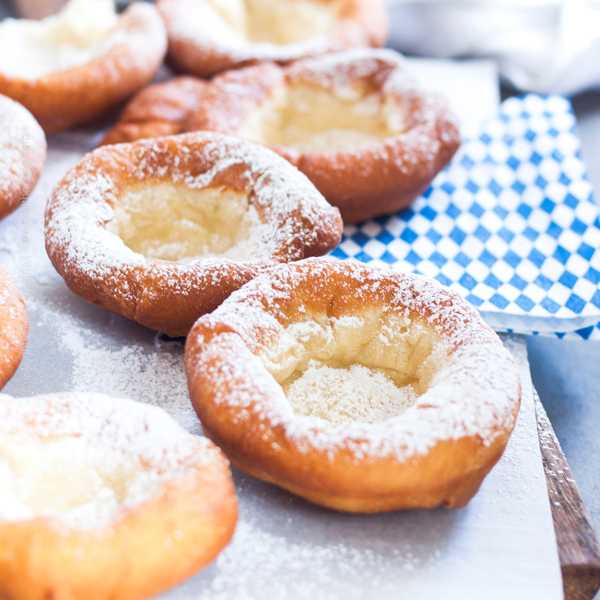
Authentic German Donuts (Bayerische Ausgezogene)
Authentic recipe for traditional Bavarian donuts aka Ausgezogene Krapfen, Knieküchle, or Auszogne. Just as they make them at the Oktoberfest Wiesn.
Ingredients
- 1 cup milk
- 3 tsp sugar
- 3 tsp dry active yeast
- 4 cups all-purpose flour
- pinch of salt
- 4 tbsp butter (soft or melted)
- 2 eggs
- frying oil as needed (vegetable or vegetable plus a shortening)*
Instructions
1. Warm up the milk (not to exceed 90 F) and pour in the bowl of a stand up mixer. Add the sugar and the yeast, gently stir and cover. Let sit for 10-15 minutes for the yeast to activate.
2. Add the flour, salt, butter and eggs to the milk and yeast mixture. Using the dough hook attachment and medium-low speed process the dough until it pulls away from the sides of the bowl. It should be soft, but not sticky. Cover with plastic wrap and let sit in a warm place until it doubles in size.
3. Once the dough has risen move it to a clean, floured surface. Divide it in two, then each part in two again and so on until you have 16 parts (do not worry about exact weight). Shape the parts into balls, space them apart and brush them with a bit of oil so they do not dry out. Cover them with plastic and then with a towel and let them rise for about 15-20 more minutes.**
4. Once the balls have doubled in size heat enough oil to cover a frying pan about 2-3 inches deep (using a large pot is easier, less splatter) to 340-350 F. Shape two-three donuts at a time and fry. The easiest way to shape them is to press your thumb into the center of each dough ball a couple of times until it flattens and widens. The sides should remain raised. For other shaping methods refer to the pictures in the post.
5. Fry with the indented side facing down first, then flip to fry the flat side taking care to not have oil pooling in the middles. Fry until golden brown and place onto paper towels or cooling rack.
6. Dip in vanilla sugar while still hot or dust with powdered sugar. Alternatively you can fill the middles with jam, Bavarian cream or Nutella.
Notes
* Traditionally these donuts were fried in two types of fat. For example 1:1 lard and butter or 1:1 shortening and vegetable oil.
**Proper rise is key to a light texture so allow as much time as necessary for the balls to double in size.
Nutrition Information:
Yield: 16 Serving Size: 1Amount Per Serving: Calories: 169Total Fat: 5gSaturated Fat: 2gTrans Fat: 0gUnsaturated Fat: 2gCholesterol: 32mgSodium: 49mgCarbohydrates: 26gFiber: 1gSugar: 1gProtein: 5g

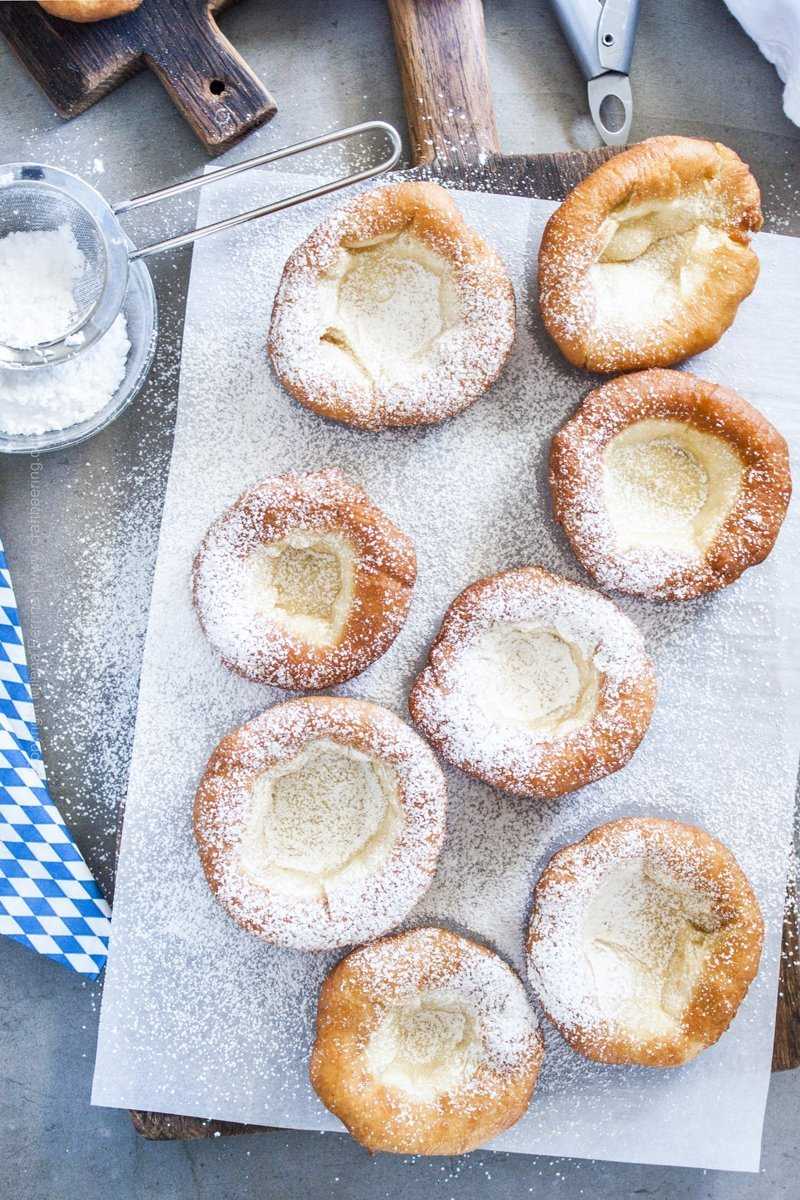
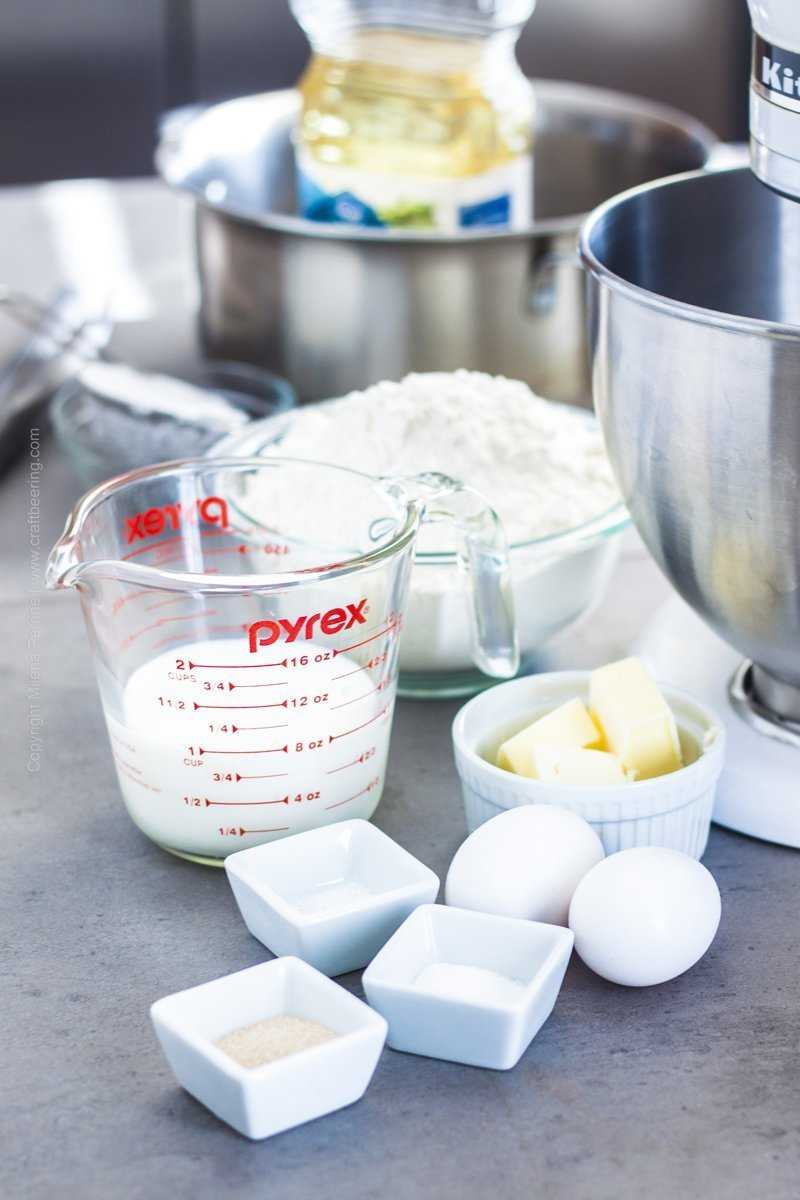
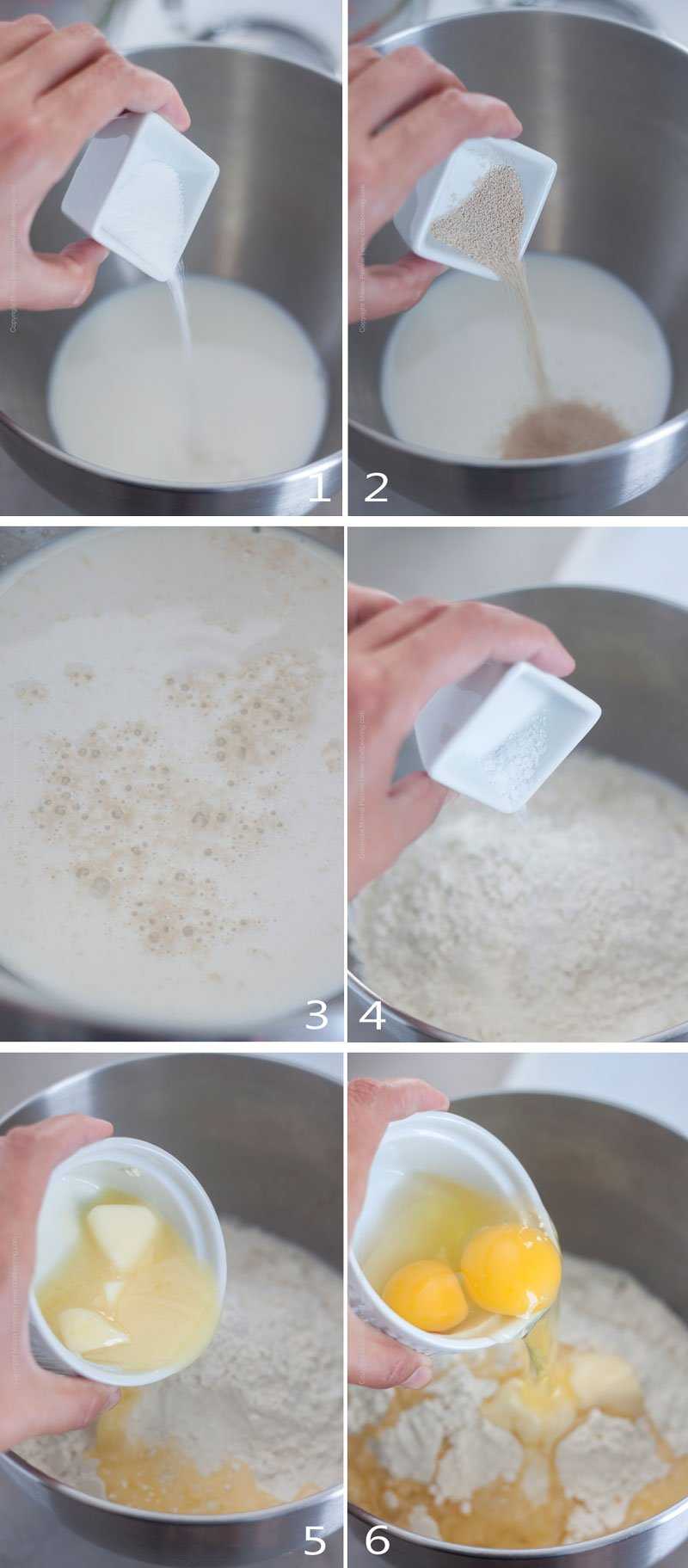
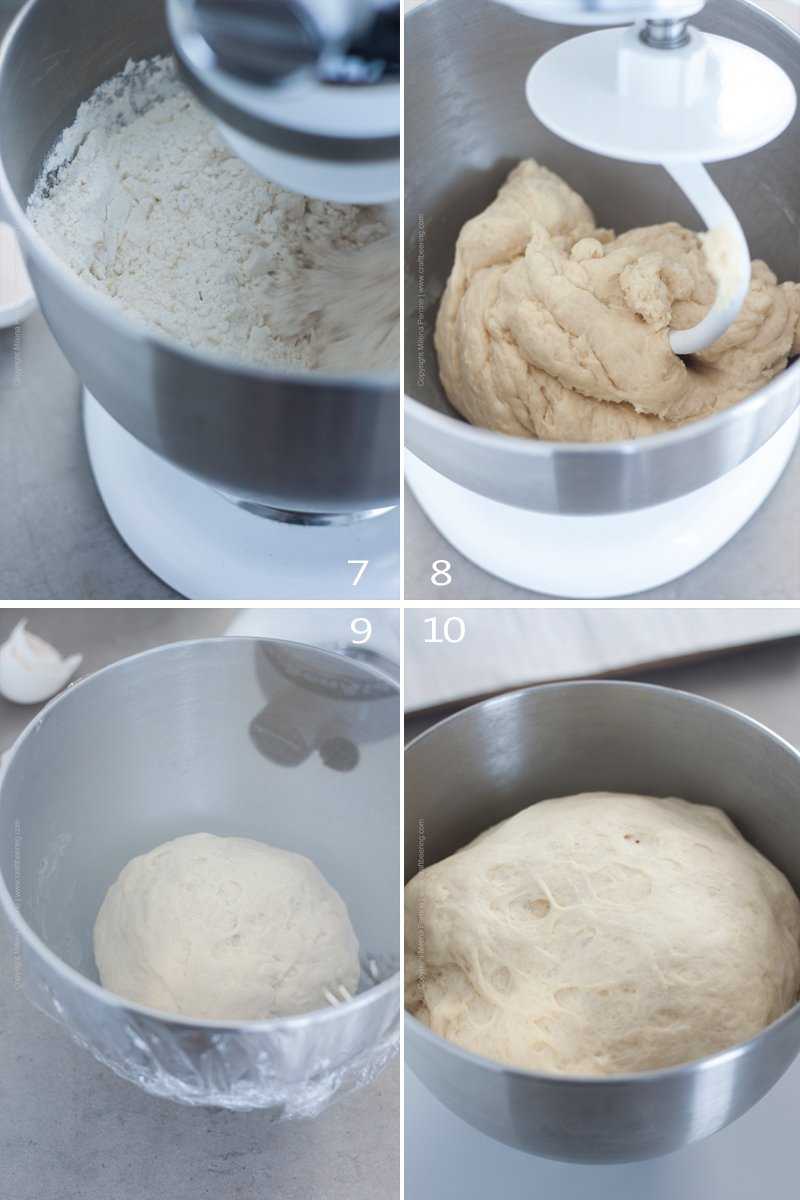
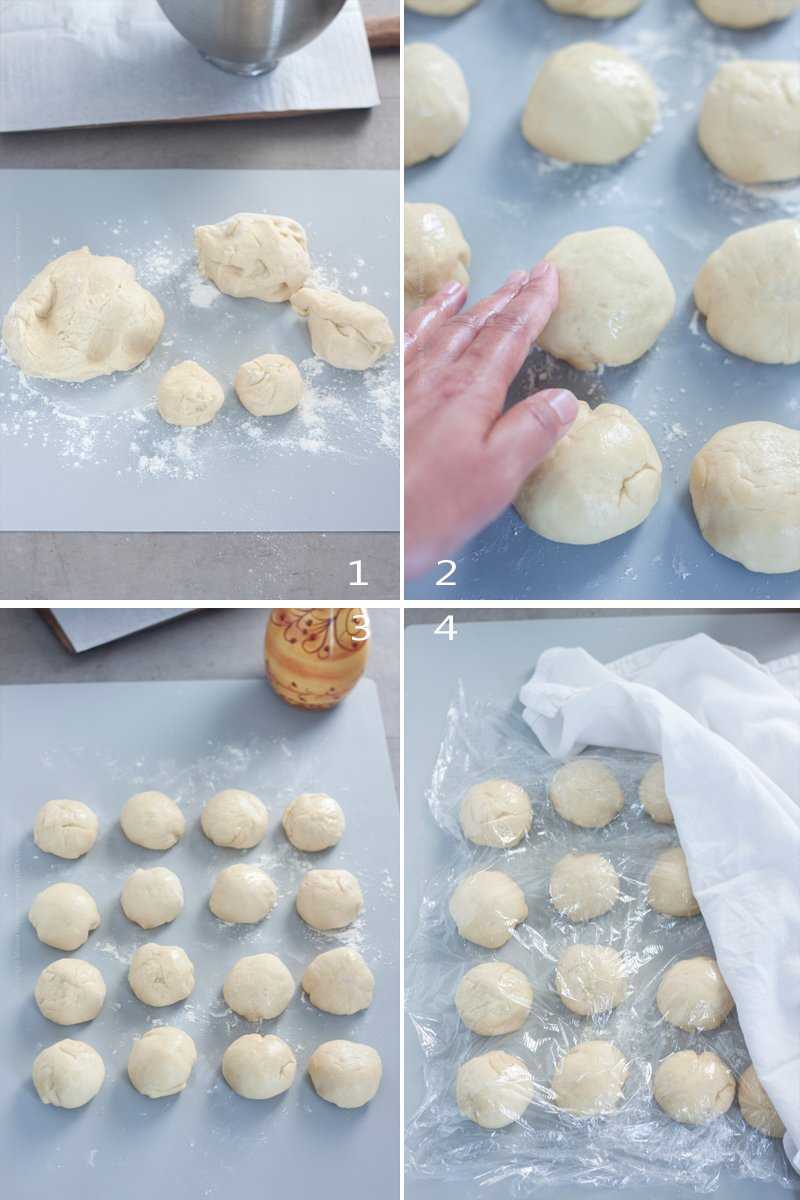
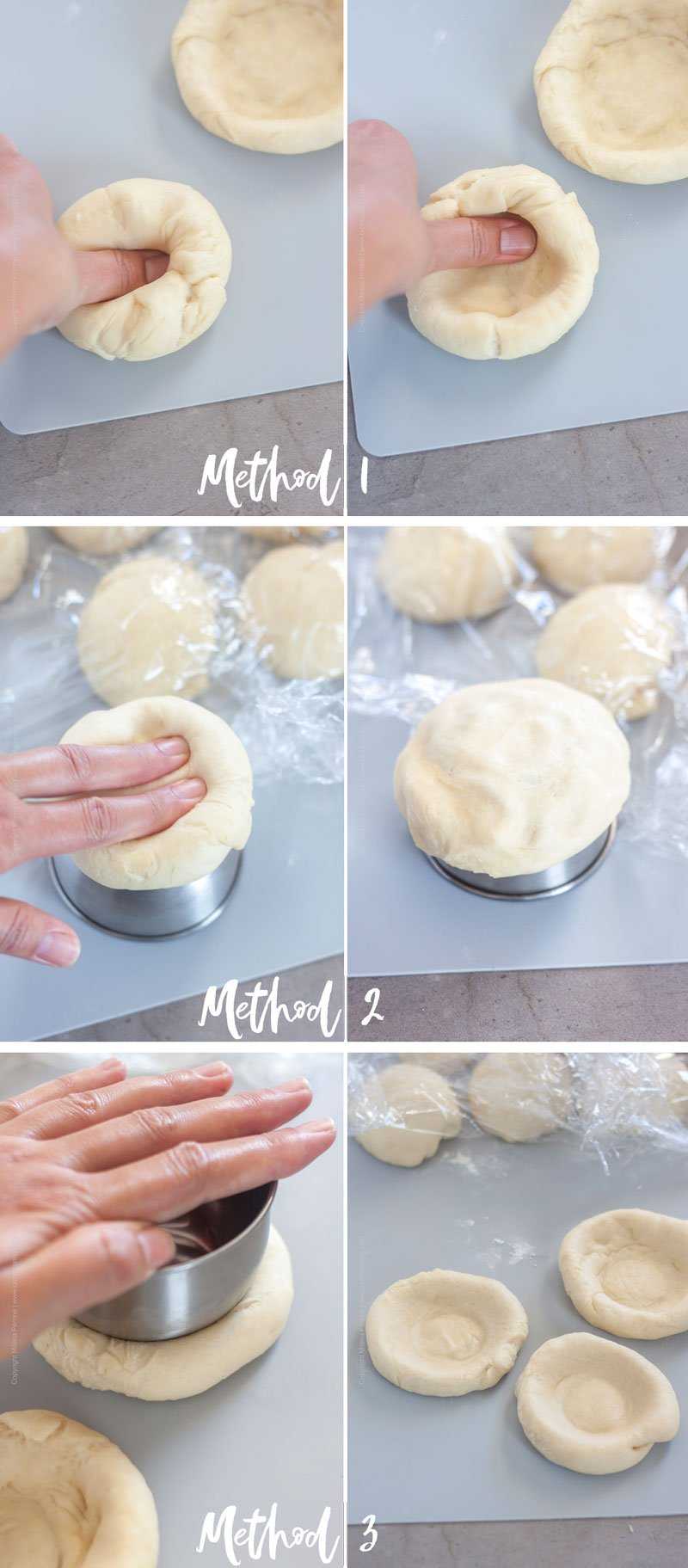
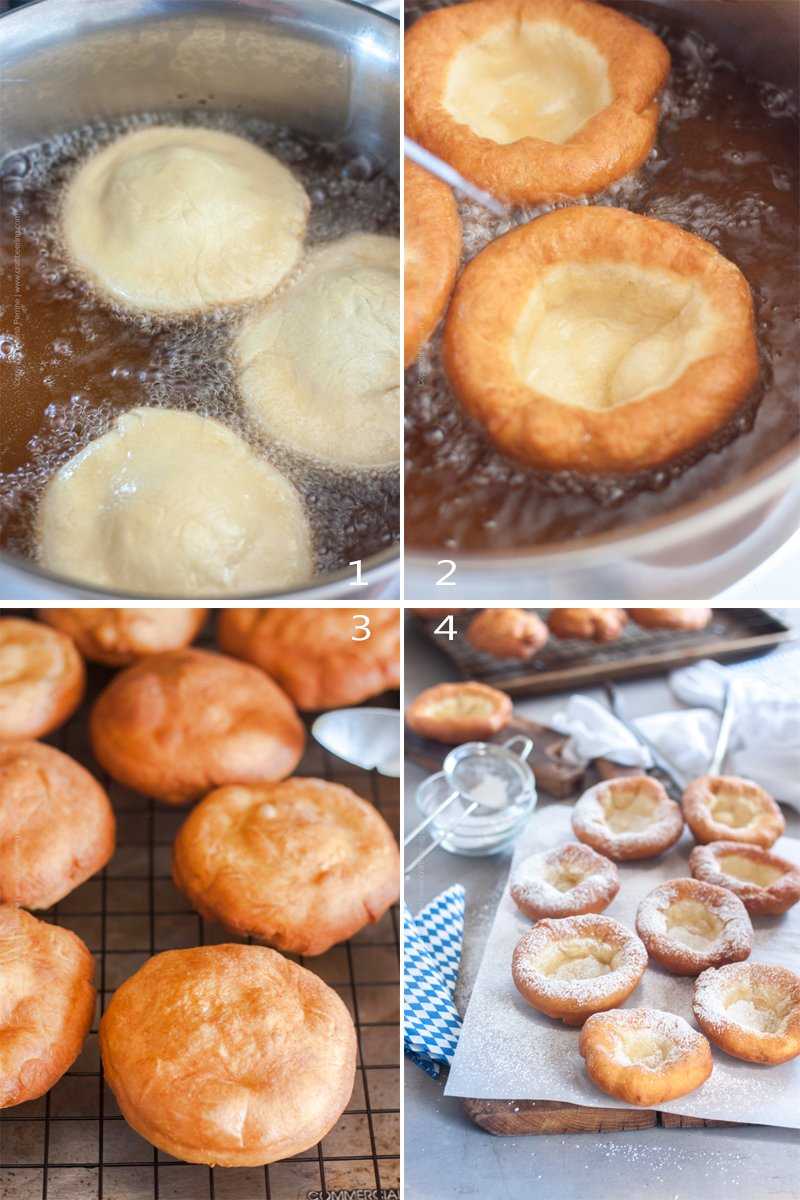
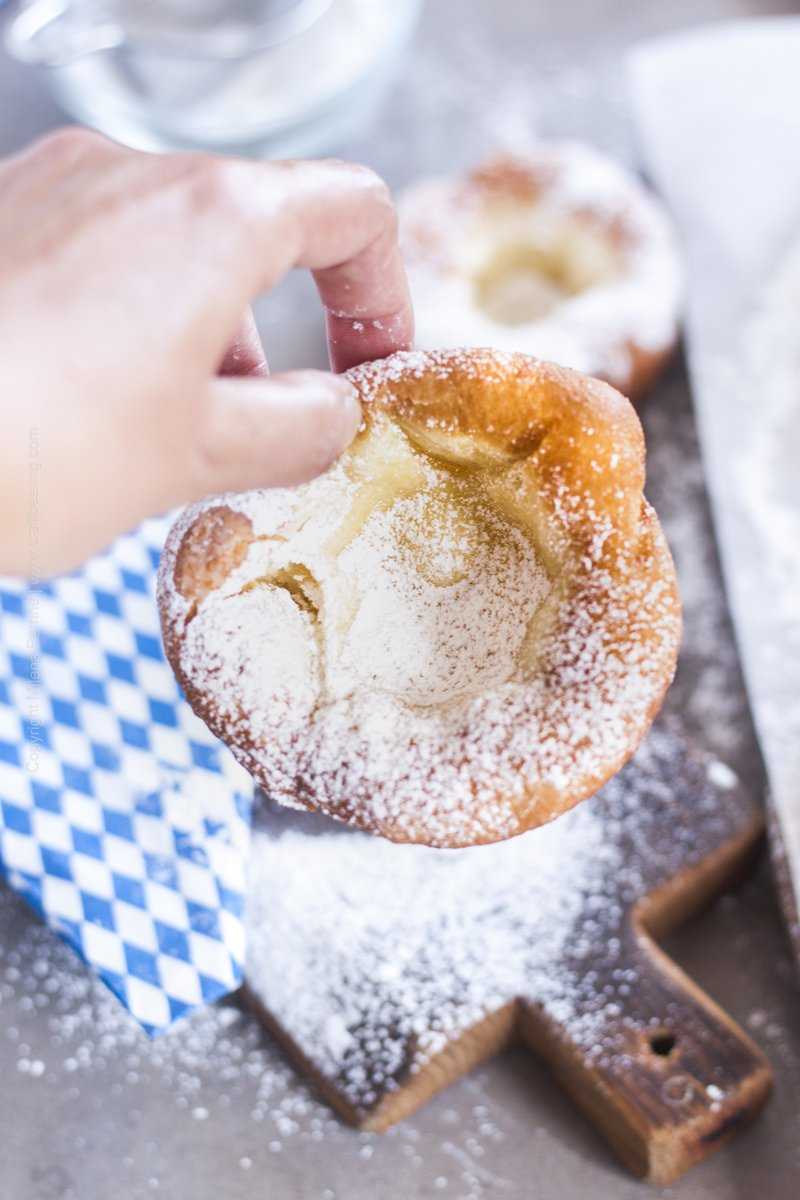
Diane says
These were something my German grandmother made often. She was born and raised in Bavaria and came to America as a young woman. My mom (her daughter) will be 92 next month. Although she was a tremendous baker these were something she didn’t make. We were talking about this recently, and since she didn’t have my grandmothers recipe, I went in the hunt to find one. Can’t wait to make these with her. My grandmother used her towel covered knee to shape these before frying.
J Kelly says
My wife’s grandmother married a man from Bavaria and she would make these. They are a cherished childhood memory of hers but we were never able to find a recipe or even a reference to them anywhere, other than a description of them my mother-in-law transcribed from her mother’s explanation. Finally today, my wife searched for Bavarian doughnuts, and here they are. Her folks called them “krupfas,” with the “up” sound as in English. Finally we know they are “Krapfen.” We are excited to have this. I am a baker and we are going to make these together soon. Thank you so much!
Milena Perrine says
Sounds great! What a great background, they will probably taste extra delicious because of your wife’s sentiments!
Elizabeth says
Yeast doughs are the easiest and most forgiving doughs to make. All you need is a little patience and time and a little knowledge what each addition actually does to the dough. No measurement really needs to be exact but is dependent on the climate.
Elizabeth says
I remember these as a child. We used to stretch the doughnuts on our knees to achieve the indentation. Is that unsanitary now or are we the only people that did that?
CraftBeering says
This sounds like fun!
Diane says
My grandmother immigrated from Bavaria, as a young woman, in the 1920’s and brought with her all of her family recipes…this being one of them. She would put a clean linen cloth over her bent knee to shape the dough. We called this ‘krapfa’. I do not recall her using rum in the recipe though.
Diane says
I remember my mother telling me that they also stretched them on their knees. So it was not only you! ( or maybe we are related.)
She said that’s how it was done back in the day. She was born in 1926.
Kelsie | the itsy-bitsy kitchen says
I’ve never had a Bavarian donut but I need to change that, like, today. These look SOOOO GOOD, I can’t even take it!
CraftBeering says
Thank you!
Melissa Griffiths says
I wish I could reach through the screen and eat these! Thanks for sharing.
Marvellina | What To Cook Today says
I’ve visited your blog several times but did not find any new posts (probably it was the cache or something!). Finally today I saw some new posts, these Bavarian donuts caught my attention immediately. They remind me of the Chinese Ham Chim Pheng! Wish I could have Bavarian donuts now!
CraftBeering says
OMG, yes, probably the cache. We changed a few plugins:)
Leanne @ Crumb Top Baking says
When yeast and dough are involved, I’m always a bit intimidated. So I appreciate your detailed description and step by step photos. I feel like I could tackle these donuts. And they look delicious! A few for breakfast with coffee works, right!? 😉
CraftBeering says
Thank you! They are so delicious and also tend to stick around one’s waist:) Simply too hard to stop at two of them.